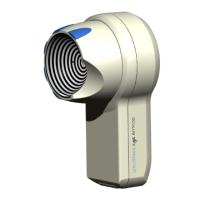Instruction Manual Easygraph
Page 55
7.5.3.3 Refraction Module / [Refraction]
The refraction module permits a calculation of the
required refraction of the contact lens as a function of
spectacle power and lens type. It also enables you to
compare different lens types (e.g. toric or bitoric) with
respect to their corrective effect.
It is advisable to complete the selection of the
posterior surface of the contact lens (i.e. the fluo
image simulation) before starting the power
calculation program via the [CL power] button (cf.
Figure at page 50). The reason for this is that
changes to the curvature of the posterior surface
necessitate additional corrective effects of the
contact lens.
The content of the “Test lens” field of the power
calculation module varies according to the selected
lens type.
The following are available:
• Test lens, rotationally symmetrical
• Test lens, toric
• Test lens, soft
The first entry you have to make in the “Spectacle
power“ field are the patient’s power values. Be sure
always to enter the cylinder value with a negative
sign. The spectacle power value is converted into
corneal vertex power on the basis of the corneal
vertex distance (CVD) and displayed in the column
“CVD=0”.
If power values have already been entered, these will
be adopted directly (cf. 7.5.2.7 “Refractive Display
Mode” page 40).
Clicking the [Suggestion] button starts the
calculation of a suggestion for a contact lens with due
consideration to the power values, the curvature of
the cornea and the selected posterior surface of the
contact lens. This suggestion (e.g. Sph: 6.25 D) is
then transferred to the “Test lens” field where it can
subsequently be edited manually. Each change of a
value is automatically followed by a calculation and
presentation of the “Expected remaining power” The
expected remaining power corresponds to the
overrefraction which would be necessary if the
contact lens were placed on the eye. The test lens
should therefore be so selected as to minimize the
expected remaining power.
Note ⇒ The “Expected remaining power“ is not a
measured but rather a calculated value
which takes
as many ocular and contact lens parameters into
account as possible (though not all). This value
should therefore be compared with the measured
overrefraction found after the selection of a contact
lens.

